

Restaurantsfail. Thesis.pdf. OC13086.pdf. Restaurant Ambiance & How It Impacts Profitablity. By Dustin Heap There are many factors that impact whether or not a restaurant is profitable.
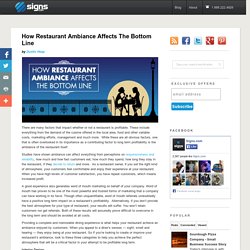
These include everything from the demand of the cuisine offered in the local area, food and other variable costs, marketing efforts, management and much more. While these are all obvious factors, one that is often overlooked in its importance as a contributing factor to long term profitability is the ambiance of the restaurant itself.
Studies have shown ambiance can affect everything from perceptions on responsiveness and reliability, how much and how fast customers eat, how much they spend, how long they stay in the restaurant, if they decide to return and more. As a restaurant owner, if you set the right kind of atmosphere, your customers feel comfortable and enjoy their experience at your restaurant. What Competitive Advantage Does a Large Restaurant Have Over a Small Restaurant? Large restaurants, typically chain restaurants with multiple locations, have profound advantages over small restaurant businesses.
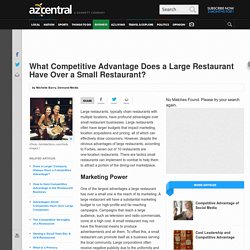
Large restaurants often have larger budgets that impact marketing, location acquisitions and pricing, all of which can effectively draw consumers. However, despite the obvious advantages of large restaurants, according to Forbes, seven out of 10 restaurants are one-location restaurants. There are tactics small restaurants can implement to combat to help them to attract a portion of the dining-out marketplace. Marketing Power One of the largest advantages a large restaurant has over a small one is the reach of its marketing.
Pricing. Untitled. We eat for pleasure as well as sustenance.
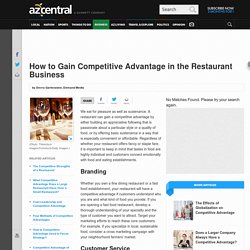
Key Success Factors for Restaurants. Having a great menu and a big marketing budget might help you attract customers to your restaurant, but it might not be enough to keep your doors open.
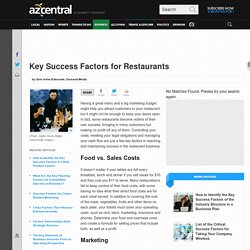
In fact, some restaurants become victims of their own success, bringing in many customers but making no profit off any of them. Controlling your costs, meeting your legal obligations and managing your cash flow are just a few key factors in reaching and maintaining success in the restaurant business. Food vs. Sales Costs It doesn’t matter if your tables are full every breakfast, lunch and dinner if you sell meals for $10 and they cost you $11 to serve. Marketing Don’t rely on word-of-mouth or paid advertising to get customers to your door. Unique Brand. The Ingredients of Restaurant Success. This story first appeared in the March 2007 issue of Entrepreneur.
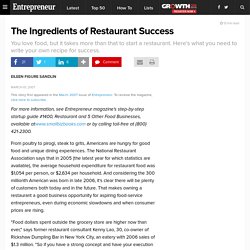
To receive the magazine, click here to subscribe. For more information, see Entrepreneur magazine's step-by-step startup guide #1400, Restaurant and 5 Other Food Businesses, available atwww.smallbizbooks.com or by calling toll-free at (800) 421-2300. From poultry to pirogi, steak to grits, Americans are hungry for good food and unique dining experiences. The National Restaurant Association says that in 2005 (the latest year for which statistics are available), the average household expenditure for restaurant food was $1,054 per person, or $2,634 per household. And considering the 300 millionth American was born in late 2006, it's clear there will be plenty of customers both today and in the future. "Food dollars spent outside the grocery store are higher now than ever," says former restaurant consultant Kenny Lao, 30, co-owner of Rickshaw Dumpling Bar in New York City, an eatery with 2006 sales of $1.3 million.
Businessinsider. Why we eat what we eat: social and economic determinants of food choice. The article highlighted the need to consider the senses when promoting dietary change.
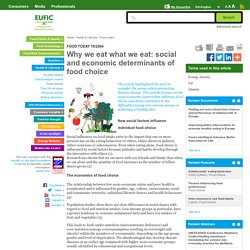
This article focuses on the socio-economic factors that influence food choice and draws attention to the difficulties facing low-income groups in achieving a healthy diet. How social factors influence individual food choice Social influences on food intake refer to the impact that one or more persons has on the eating behaviour of others, either direct or indirect, either conscious or subconscious. Even when eating alone, food choice is influenced by social factors because attitudes and habits develop through the interaction with others (1). Research has shown that we eat more with our friends and family than when we eat alone and the quantity of food increases as the number of fellow diners grows (2). How to Gain Competitive Advantage in the Restaurant Business.
The restaurant industry is highly competitive.
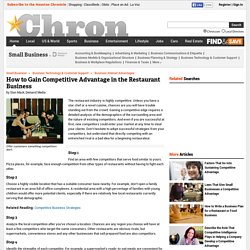
Unless you have a star chef or a novel cuisine, chances are you will have trouble standing out from the crowd. Gaining a competitive edge requires a detailed analysis of the demographics of the surrounding area and the nature of existing competitors. And even if you are successful at first, new competitors could enter your market at any time to steal your clients. Don’t hesitate to adopt successful strategies from your competitors, but understand that directly competing with an entrenched rival is a bad idea for a beginning restaurateur. Step 1 Find an area with few competitors that serve food similar to yours.
Step 2 Choose a highly visible location that has a suitable consumer base nearby. Related Reading: Competitive Business Strategies Step 3 Analyze the local competition after you’ve chosen a location. Step 4 Identify the strengths of each competitor. Step 5.